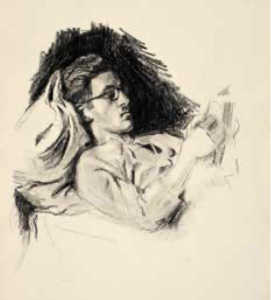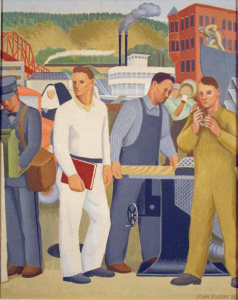

Biography
Born in the small town of DeWitt, Iowa, John Bloom moved to Davenport at age 18 to attend St. Ambrose College, after which he enrolled at the Art Institute of Chicago in 1926. His prize-winning painting "The Burial" won first prize at the Iowa State Fair and attracted the attention of Grant Wood, who invited him to join the Stone City Art Colony in 1932. Having exhausted his family's financial resources during his stay at the Art Institute, Bloom had to support himself at Stone City by working as the Colony's custodian. This led to his "meet cute" with Isabel Scherer, who was working on a sculpture when Bloom chided her for making a mess that he would have to clean up. During their marriage, Scherer blossomed as a sculptor, developing a technique for cast concrete that allowed her to build a nationwide business in cast concrete figurines.Bloom received commissions for two Post Office murals, both of which show the strong influence that Grant Wood had on his work. To support his growing family, Bloom worked as an industrial designer four days a week, while experimenting with lithography on the weekend. He continued work as an industrial designer through World War II, with employment at the Rock Island Arsenal. Following the War, Bloom had a number of similar jobs. His collected papers at Iowa State University show an amazing range of topics covered by this work. Meanwhile he never ceased to sketch scenes of Davenport and work at wood carving, an activity he had picked up in childhood.
Retiring in 1969, he devoted full time to sketching, often roaming about Davenport in search of interesting subjects. He developed a habit of dropping into David Losasso's gallery Mississippi Fine Art. Losasso expressed an interest in Bloom's art, helped him to print some lithographs from the 1940s, and encouraged him to create new lithographs. This led to a solo exhibit at Mississippi Fine Art and commissions for new murals, typically based on designs that Bloom had developed in the 1930s.


Critical Analysis
Bloom was a very competent, if not ground-breaking, muralist. His drawings show a fine hand and a wonderful eye for detail and composition. His lifelong interest in wood carving may have helped him create the three-dimensional feeling that his murals project. His work is well-represented in regional museums, and his DeWitt mural holds an honored place in the town's history.Murals
- DeWitt, Iowa - City Hall: Shucking Corn
- Tipton, Iowa - Post Office: Cattle
References
- Julie Jensen, 'Eye for Life' showcases art of John Bloom, The Dispatch and Rock Island Argus December 11 (2002).
- Jonathan Turner, 'John Bloom: Visions of Iowa' Opens at the Figge, Dispatch Argus February 18 (2009).
- Bloom John Vincent, Jr. (Bloom, Tragni, Austin, Hicket - Family Histories).
- Curt Swarm, Close to Home, The Oskaloosa Herald January 20 (2019).
- County Fair (the daily palette).
- Dubuque Mural Project (Muscatine Art Center).
- Isabel Bloom: The Artist (Isabel Bloom). The sculptor Isabel Bloom was married to John Bloom.
- John Bloom (John Bloom).
- John Bloom (1906-2002): Papers, 1914-1997 (Iowa State University Special Collections and University Archives).
- John Bloom: Close to Home, Views From the Figge Fall 2018, Issue 33, p.8 (2018).
- Vanessa Sage, John Bloom: Close to Home. Figge Art Museum , Davenport, Iowa (2018).
- John Bloom: Close to Home (Figge Art Museum).
- John Vincent Bloom, Daniel E. Stetson, Julie McDonald, John Bloom: Living Regionalism. Davenport Museum of Art , Davenport, Iowa (1988).
- John Bloom: The Regionalist and Me (John Brassard Jr.: The Kitchen Table Historian).
- John Vincent "Bunk" Bloom (Davenport Iowa History).
- John Vincent Bloom (When Tillage Begins: The Stone City Art Colony and School).
- Jonathan Turner, Remembering John: Regionalist John Bloom's work explores Midwest themes, Radish Magazine June 1 (2009).
- Anne Marie Amacher, St. Ambrose exhibit displays works of three late Quad-City artists, The Catholic Messenger March 22 (2012).